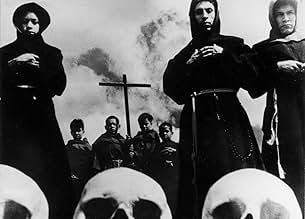AVALIAÇÃO DA IMDb
7,4/10
1,9 mil
SUA AVALIAÇÃO
Adicionar um enredo no seu idiomaEisenstein shows us Mexico in this movie, its history and its culture. He believes, that Mexico can become a modern state.Eisenstein shows us Mexico in this movie, its history and its culture. He believes, that Mexico can become a modern state.Eisenstein shows us Mexico in this movie, its history and its culture. He believes, that Mexico can become a modern state.
- Direção
- Roteiristas
- Artistas
- Prêmios
- 1 vitória no total
- Direção
- Roteiristas
- Elenco e equipe completos
- Produção, bilheteria e muito mais no IMDbPro
Enredo
Você sabia?
- CuriosidadesItalian censorship visa # 75561 delivered on 25 September 1980.
- Erros de gravaçãoThe rifles Sebastian and his friends take from the gallery are of lever-action design, in the following gun-fight in the cactus fields they unmistakably use single-shot bolt-action rifles.
- ConexõesEdited from Que viva Mexico! (1932)
Avaliação em destaque
Considering that Que Viva Mexico was (mostly) made by Sergei Eisenstein, and funded by Upton Sinclair, the most happy surprise is that the film isn't overloaded with the kind of communist/socialist propaganda that would be immediately expected. It's not that this would be a bad thing in the technical sense; Eisenstein, on the front of being a pure visionary, couldn't be stopped no matter how thin he stretched himself for his means as a director who had to stay to party/country guidelines. And for Sinclair, the meatier the context the better the hyperbole. But with Que Viva Mexico! we get a view of the people and customs like out of a measured fever dream. We're given more-so the customs and the traditions, the practice of a marriage, the bullfights, some of the context of the history behind those 'Day of the Dead' parades. Only here and there are any blatant pleas seen and heard loud and clear (mostly involving the poorest of the poor in the lot).
Actually, it could be something, in a sense, comparable to Werner Herzog in attempting the documentary form. It's not quite fiction, but it's presenting documentary in a stylized manner, where things aren't simply stock footage but very much a set-up of the construction of drama in the scenes and scene-location specific shots and angles. And like Herzog, Eisenstein has a poet's eye for visions that many might only see in the most remote history books or travelogues. While the accompanying narration for Que Viva Mexico is a little on the creaky end, there's no lack of splendor for the senses as far as getting an eye full of carefully picked locals (i.e. the girl Concepcion for the marriage scenes) or for mixing real documentary footage of the bullfight with careful constructed shots of the bullfighter before and after the fact. Even the music plays a nifty role in the dramatization of events. And here and there, especially as the film rolls along in its last third, a subtle sensation of the surreal drifts into the proceedings.
Unfortunately, like It's All True for Orson Welles, Que Viva Mexico remains something of a carefully plucked fragment from a lost bit in the director's career. It's a minor marvel, and certainly more than a curiosity for the die-hard documentary or Mexican history buff, but it's stayed obscurer than Eisenstein's more infamous pieces (Potemkin, Alexander Nevksy) for a reason. Despite all the best intentions to simply reveal the cultural day-to-day workings and a little of the socio-political context of the Conquistadors' impact, it's a cool curiosity at best.
Actually, it could be something, in a sense, comparable to Werner Herzog in attempting the documentary form. It's not quite fiction, but it's presenting documentary in a stylized manner, where things aren't simply stock footage but very much a set-up of the construction of drama in the scenes and scene-location specific shots and angles. And like Herzog, Eisenstein has a poet's eye for visions that many might only see in the most remote history books or travelogues. While the accompanying narration for Que Viva Mexico is a little on the creaky end, there's no lack of splendor for the senses as far as getting an eye full of carefully picked locals (i.e. the girl Concepcion for the marriage scenes) or for mixing real documentary footage of the bullfight with careful constructed shots of the bullfighter before and after the fact. Even the music plays a nifty role in the dramatization of events. And here and there, especially as the film rolls along in its last third, a subtle sensation of the surreal drifts into the proceedings.
Unfortunately, like It's All True for Orson Welles, Que Viva Mexico remains something of a carefully plucked fragment from a lost bit in the director's career. It's a minor marvel, and certainly more than a curiosity for the die-hard documentary or Mexican history buff, but it's stayed obscurer than Eisenstein's more infamous pieces (Potemkin, Alexander Nevksy) for a reason. Despite all the best intentions to simply reveal the cultural day-to-day workings and a little of the socio-political context of the Conquistadors' impact, it's a cool curiosity at best.
- Quinoa1984
- 7 de abr. de 2008
- Link permanente
Principais escolhas
Faça login para avaliar e ver a lista de recomendações personalizadas
- How long is Que Viva Mexico?Fornecido pela Alexa
Detalhes
- Tempo de duração1 hora 30 minutos
- Cor
- Mixagem de som
- Proporção
- 1.37 : 1
Contribua para esta página
Sugerir uma alteração ou adicionar conteúdo ausente

Principal brecha
By what name was Que Viva México! (1979) officially released in India in English?
Responda




















